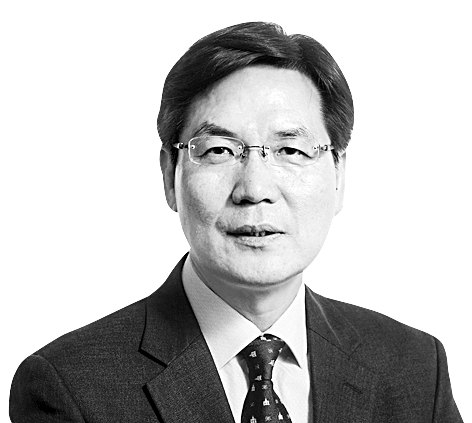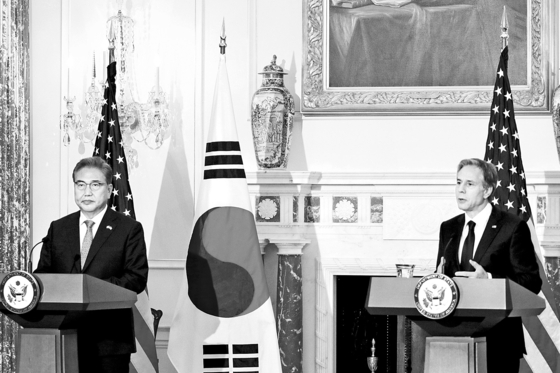Would United States risk New York to protect Seoul?
Published: 26 Jun. 2022, 20:01
Updated: 27 Jun. 2022, 15:28

The author is an editorial writer and former director of the Institute for Military and Security Affairs at the JoongAng Ilbo.
Would Washington risk New York to protect Seoul?
In a meeting with U.S. President John F. Kennedy in 1961, French President Charles de Gaulle asked if the United States would be willing to risk New York and Washington to defend Paris. At that time, the United States was trying to dissuade France from developing nuclear weapons by promising to protect it from a Soviet Union nuclear attack with its nuclear umbrella. But de Gaulle rushed to develop nuclear weapons and downgraded membership in the North Atlantic Treaty Organization (NATO) due to his suspicions about the nuclear umbrella.
The Korean Peninsula is entering a new nuclear era. In an expanded meeting of the Workers’ Party of North Korea from June 8 to 10, North Korean leader Kim Jong-un, chairman of the mighty State Affairs Commission, declared a “head-to-head war with enemies” after underscoring the importance of self-defense against external threats. In a military parade in April, he vowed to use nuclear weapons preemptively, a dramatic shift from defensive to offensive posture in his nuclear strategy.
In response, South Korean President Yoon Suk-yeol specified a “nuclear counteraction” in a statement announced after his summit with U.S. President Joe Biden on May 21 in Seoul. The counteraction refers to curbing the North’s nuclear threats through extended nuclear deterrence. Four days later, Yoon ordered the military to take substantial steps to activate the extended deterrence in case North Korea fires missiles.

The Stockholm International Peace Research Institute (Sipri) estimates that North Korea has assembled 20 warheads and obtained enough nuclear material to make 45 to 55 warheads. It is developing ballistic missiles that can carry warheads. It tested ballistic missiles, including ICBMs, 18 times so far this year. The ICBMs target the U.S. mainland.
When North Korea conducts its seventh nuclear test, it will be able to produce a tactical warhead weighing less than 200 kilograms (441 pounds). If such small warheads are loaded onto the KN-23 — a North Korean version of the Iskander, a Russian short-range ballistic missile system — they will be very difficult to intercept due to their mid-flight maneuverability. The KN-23 with the 600-kilometer shooting range can strike any part of South Korea.
North Korea is expected to have over 100 warheads soon. They can be placed on short-range ballistic missiles, ICBMs and SLBMs. The first goal of North Korea is to acquire the capability to strike back with nukes after suffering a retaliation by the ROK-U.S. Combined Forces after the North’s first nuclear attack. North Korea wants to ward off any attack. The problem is that it could use nuclear weapons for offensive purposes, not defensive, which is different from other nuclear powers. Its targets are South Korea, the U.S. and Japan.
In a seminar hosted by the Korea-America Association on May 19, Evans J.R. Revere, a former acting ambassador to Korea, linked North Korean nuclear weapons to the need for Kim Jong-un to “unify the Korean Peninsula, not to maintain his regime.” Revere went on to say, “Since denuclearizing North Korea is nearly impossible now, it is time to cope with its nuclear threats.” South Korea has two choices, he said. One is surrendering to the North’s nuclear threats and the other is convincing Pyongyang of its demise if it uses nuclear weapons.
The first option to deal with the North’s nuclear threats is nuclear armaments for the South. In a survey in February by the Chicago Council on Global Affairs (CCGA) of 1,500 South Koreans, 71 percent supported nuclear arms for their country. Some of them demanded America consider nuclear arming of its ally, but it is not an easy choice given all the risks involved. And yet, we need to keep the idea open as an option.
If South Korea cannot have nuclear weapons, it has no other choice but to rely on U.S. extended deterrence, which includes nuclear weapons, missile defense systems, and command and control systems. According to the Pentagon, extended deterrence means ensuring that adversaries of U.S. allies don’t make dangerous miscalculations about what they can get away with based on what they think the U.S. is capable of or willing to do in response. But if the U.S. hesitates to take action when North Korea chooses a nuclear provocation, extended deterrence fails.
If extended deterrence is to succeed, the U.S. must immediately retaliate against an enemy with its own nukes. But suspicion arises over whether America really can do that, as suggested by de Gaulle. Would the United States be willing to leave New York vulnerable to ICBM attacks from North Korea to defend Seoul? Pyongyang could threaten Tokyo with nuclear missiles to prevent Washington from using its military bases in Japan. That poses the risk of the U.S. and Japan being taken hostage to North Korean nuclear weapons.
The U.S. reportedly has not included a nuclear option in its military operations. During the Gulf War in 1991, Washington considered that option, but gave it up. Therefore, there is hardly any possibility of using that option on the Korean Peninsula, according to Prof. Song Seung-jong, an expert in military affairs at Daejeon University. Such a nuclear option with no probability of execution is called a “torn umbrella.”
In what can be dubbed the Healey theorem, former British defense minister Denis Healey famously said that it only takes a 5 percent belief in American retaliation to deter an attack, but it takes 95 percent belief to reassure the allies. He reached the conclusion in 1964 after attending a countless number of meetings on NATO defending Europe from Russia’s nuclear threats.
The United States eventually forward-deployed its tactical nukes to five members of NATO to ease the suspicions of Europeans and reassure them that U.S. tactical weapons can be used if needed, as they are positioned in Europe.
Could U.S. tactical weapons be redeployed in South Korea by the same logic? A CCGA survey showed that 56 percent of South Koreans supported it. The U.S. pulled all tactical nukes from South Korea in 1991 after deploying them in 1958.
But critics say a redeployment could destabilize the peninsula since North Korea already possesses nuclear weapons. In other words, the North could be tempted to use them if U.S. tactical weapons are redeployed in the South. Neither Seoul nor Washington support the policy of redeployment.
An alternate option is a so-called phased and adaptive policy aimed at easing concerns about extended deterrence and coping with the North’s nuclear weapons in a realistic way. The idea was initially suggested by Shane Smith, a senior research fellow at the National Defense University’s Center for the Study of Weapons of Mass Destruction, in a May 2020 commentary on “38 North,” a website devoted to analyzing North Korea. Smith once worked for Defense Secretary William Perry.
Phased adaptation refers to meeting preconditions for the activation of the nuclear umbrella before an imminent attack from North Korea. If such preparations are done, the time needed to deploy U.S. nukes in times of crisis can be cut. That can also enhance trust in the nuclear deterrence.
Phased adaptation has four steps: first, searching for a location that fits the deployment of tactical nukes; second, joint training aimed at guarding the periphery of the nuclear depot and responding to possible accidents; third, joint drills for F16 or F35 stealth fighter jets to carry out missions during peacetime; fourth, building a facility to store tactical weapons in an emergency.
Demonstration of a determination to use extended deterrence at times of contingency can pressure China and Russia to dissuade North Korea from resorting to nuclear attacks. At the same time, such moves can build trust in the deterrence as well as facilitate communication to discuss concrete ways to extend the unilateral deterrence.
But extended deterrence is not a panacea. South Korea must reinforce an ability to defend itself based on the three-axis system: a Kill Chain pre-emptive strike system, the Korean Air and Missile Defense (KAMD) system and the Korea Massive Punishment and Retaliation (KMPR) plan. The country must have the ability to destroy all missile bases in the North if it fires a missile at South Korea.










with the Korea JoongAng Daily
To write comments, please log in to one of the accounts.
Standards Board Policy (0/250자)